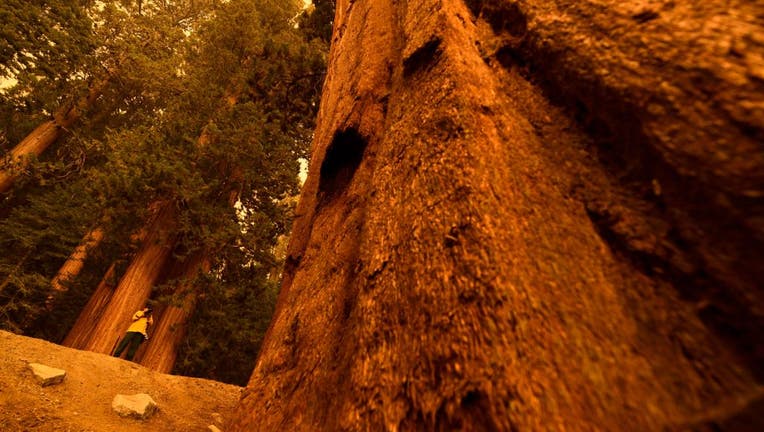Wildfires make run toward giant sequoia groves in the Sierra Nevada

A photographer (L) takes pictures of giant sequoia trees among smoke filled skies in the "Lost Grove" along Generals Highway north of Red Fir during a media tour of the KNP Complex fire in the Sequoia National Park in California on September 17, 2021
THREE RIVERS, Calif. - Crews were watching the weather this weekend as they battled California wildfires that have burned into some groves of ancient sequoias as they try to protect the world's largest tree.
The National Weather Service issued a weather watch for critical fire conditions in the Sequoia National Park in the Sierra Nevada, where two lightning-caused fires merged Friday after making its largest growth in a week. The fire reached the western tip of the Giant Forest, where it burned four sequoias known as the "Four Guardsmen" that flank the road into the grove of 2,000 sequoias.
The extent of the fire's damage on the trees has not been determined.
Firefighters have wrapped the base of the General Sherman Tree, along with other trees in the Giant Forest, in fire-resistant aluminum of the type used in wildland firefighter emergency shelters and to protect historic wooden buildings, fire spokeswoman Katy Hooper said.
The General Sherman Tree is the largest in the world by volume, at 52,508 cubic feet, according to the National Park Service. It towers 275 feet high and has a circumference of 103 feet at ground level.
The fires, known together as the KNP Complex, burned 28 square miles of forest land after making a significant run Friday. Low-hanging smoke that had choked off air and limited the fire's growth in recent days lifted, and gusts increased fire activity particularly near the Giant Forest, Hooper said.
The flames chased away firefighters who were wrapping the sequoias in aluminum and clearing vegetation on the forest floor that would intensify fire close to the trees, Hooper said. A hotshot crew was assessing conditions near the Four Guardsmen Saturday morning to determine whether firefighters can safely go back and continue the work, she said.
The fires forced the evacuation of the park this week, and parts of Three Rivers, a foothill community of about 2,500 people outside the park's main entrance. Crews have been bulldozing a line between the fire and the community.
The National Weather Service issued a red flag warning through Sunday, saying some gusts and lower humidity could create conditions for rapid wildfire spread.
However, fire officials weren't expecting the kinds of explosive wind-driven growth that in recent months turned Sierra Nevada blazes into monsters that devoured hundreds of homes.
Giant sequoias are adapted to fire, which can help them thrive by releasing seeds from their cones and creating clearings that allow young sequoias to grow. But the extraordinary intensity of fires — fueled by climate change — can overwhelm the trees.
"Once you get fire burning inside the tree, that will result in mortality," said Jon Wallace, the operations section chief for the KNP Complex.
The fires already have burned into several groves containing trees as tall as 200 feet feet tall and 2,000 years old.
To the south, the Windy Fire grew to 19 square miles on the Tule River Indian Reservation and in Giant Sequoia National Monument, where it has burned into the Peyrone grove of sequoias and threatens others.
The fire also had reached Long Meadow Grove, where two decades ago then-President Clinton signed a proclamation establishing its Trail of 100 Giant Sequoias as a national monument.
Fire officials haven’t yet been able to determine how much damage was done to the groves, which are in remote and hard-to-reach areas. They said crews were "doing everything they can" to protect the trail by removing needles, leaves and other fuels from around the base of the trees.
Last year, the Castle Fire killed an estimated 7,500 to 10,600 large sequoias, according to the National Park Service. That was an estimated 10% to 14% of all the sequoias in the world.
The current fires are eating through tinder-dry timber, grass and brush.
In far Northern California, an early season rain was a welcome sign for firefighters battling a cluster of wildfires ignited by lightning in the Klamath National Forest in late July. Fire officials say it won’t extinguish the nearly 300-square-mile blaze, but will help crews reach their goal.
Light rain is expected in the coastal area north of San Francisco over the weekend, but forecasters say conditions are likely to dry out by early next week, prompting a fire weather watch that may lead to power shutoffs in Napa, Sonoma and Solano counties.
Historic drought tied to climate change is making wildfires harder to fight. It has killed millions of trees in California alone. Scientists say climate change has made the West much warmer and drier in the past 30 years and will continue to make weather more extreme and wildfires more frequent and destructive.
More than 7,000 wildfires in California this year have damaged or destroyed more than 3,000 homes and other buildings and torched well over 3000 square miles of land, according to the California Department of Forestry and Fire Protection.

